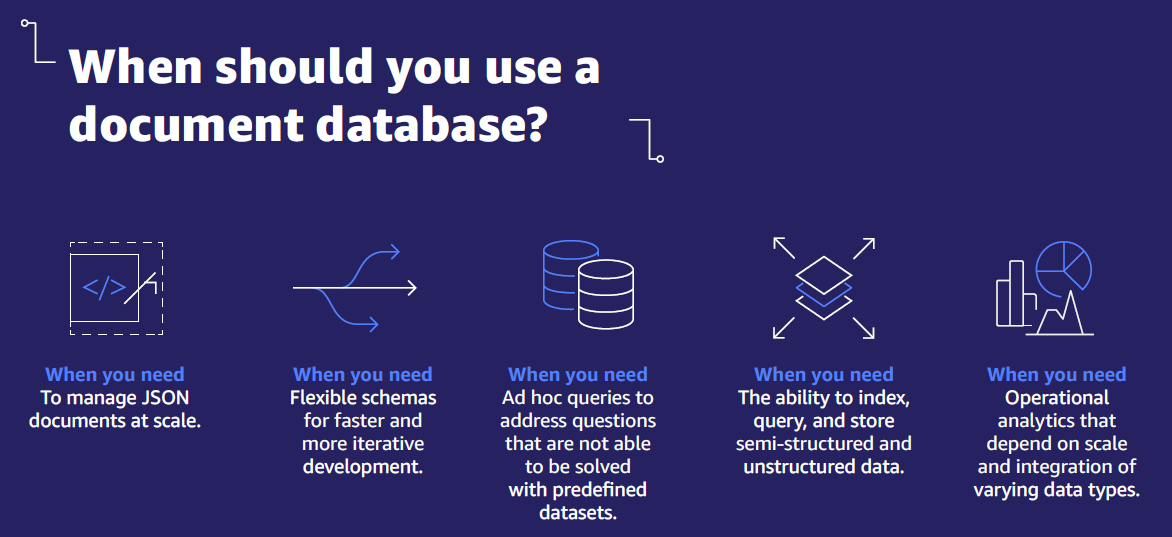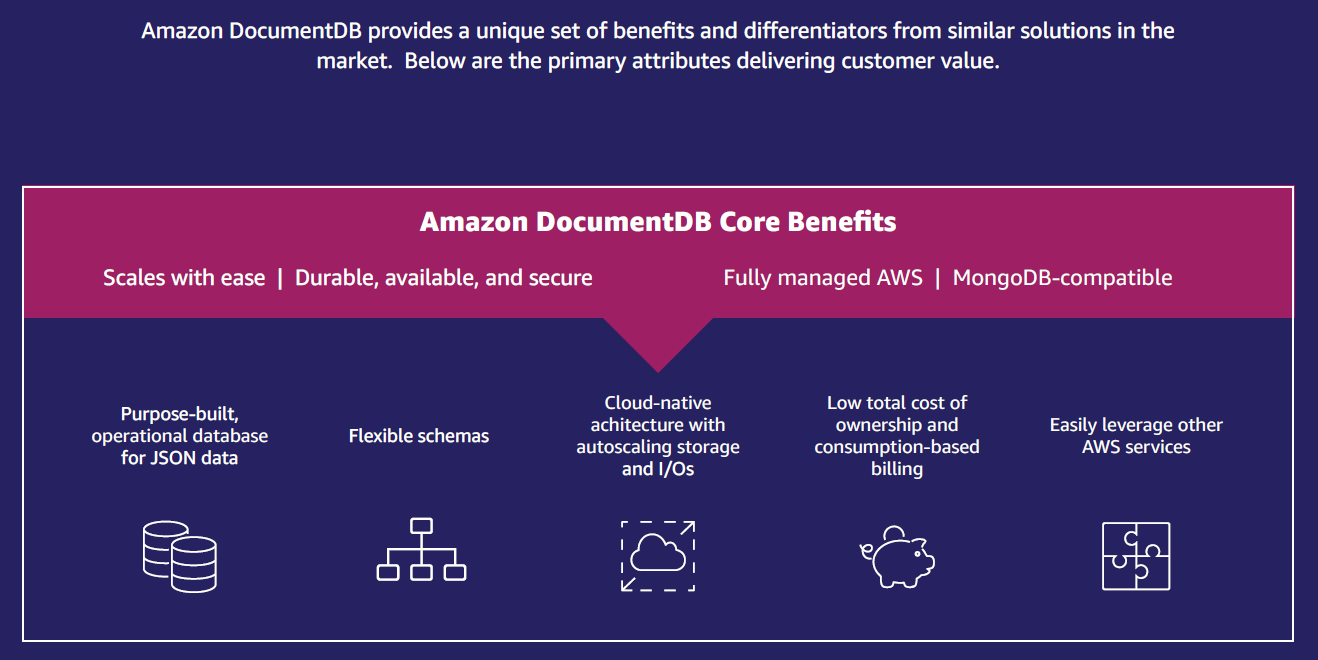AWS Public Sector Blog
The value of document databases in the public sector: A spotlight on Amazon DocumentDB
Document databases make it simpler for developers to store and query data in a database by using the same document-model format they use in their application code. The flexible, semi-structured, and hierarchical nature of documents and document databases allows them to evolve with applications’ needs. The document model works best with catalogs, user profiles, and content management systems (CMSs) where each document is unique and evolves over time. Document databases support flexible indexing, powerful ad hoc queries, and analytics over collections of documents. In response to customer demand, in 2019, Amazon Web Services (AWS) launched Amazon DocumentDB (with MongoDB compatibility). Amazon DocumentDB is a fast, scalable, highly available, and fully managed document database service that supports MongoDB workloads. This blog post details how public sector organizations are using Amazon DocumentDB, and why so many organizations are turning to this purpose-built database to address JavaScript Object Notation (JSON) intensive applications.
What are Amazon DocumentDB use cases?
Image 1. Organizations and businesses use Amazon DocumentDB for content management, mobile and web applications, personalization, catalogs, internet of things (IoT), and profile management.
Amazon DocumentDB for the public sector
Traditional database technologies lack functional scalability, have rigid data models, don’t fully align to new developer languages and tools, and modern developers are often unfamiliar with these legacy technologies. In addition, these database engines are expensive, and often include punitive licensing models that create lock-in and inhibit the implementation of new technologies. Amazon DocumentDB lets customers break away from these restrictive licenses, and it allows teams to quickly adjust database resources to meet application demand without having to revisit their licensing terms and conditions.
Document databases are most commonly used for content and catalog management. Financial regulatory agencies like FINRA often use document databases to manage regulatory documents and financial trades. They choose Amazon DocumentDB because it natively stores data in JSON, making it simpler to query and index regulatory documents. Education technology companies (EdTechs) choose document databases to not only store and manage content and its associated metadata, but also use these databases as the backend for online learning modules. Additionally, they use document databases coupled with advanced analytics to create search or recommendation engines to engage better with students.
Mexico-based EdTech Knotion provides learning systems for schools with trans-disciplinary content for students; they use AWS to scale and reliably distribute content to 50,000 students across 150 schools. Knotion chief technology officer (CTO) Hernan Ramirez Mirabent said, “At Knotion, we use Amazon DocumentDB (with MongoDB compatibility) for our learning module called Class Journey. With Class Journey, thousands of students can track their progress across several tasks in the module. All activity for our learning module is modeled as JSON documents in Amazon DocumentDB. We chose Amazon DocumentDB because of its unique architecture, reliability, scalability, performance, and seamless integration with other AWS services such as Lambda, S3, and Elastic Beanstalk. Particularly painful database management tasks such as backups, patching, setting up high availability, and scaling are available out of the box, freeing up our time to improve Knotion’s learning modules rather than managing our databases.”
Similarly, educational publishers deploy recommendation engines to serve up content for consideration to website and application users. In state and local governments, startups, and nonprofits, document databases can also be used with Internet of Things (IoT) for traffic monitoring, predictive maintenance, or inventory management. Document databases are ideal data stores for their ability to ingest varying data types and high volumes of data. Across the public sector, organizations use document databases in the modernization of legacy mainframe deployments, as organizations look to migrate key applications to a modern data platform. For a full list of Amazon DocumentDB customers and use cases, visit our resources page.
When should you use a document database?
Image 2. When should you use a document database? 1) When you need to manage JSON documents at scale; 2) when you need flexible schemas for faster and more iterative development; 3) when you need ad hoc queries to address questions that are not able to be solved with predefined datasets; 4) when you need the ability to index, query, and store semi-structured and unstructured data; and 5) when you need operational analytics that depend on scale and integration of varying data types.
Flexible schema for fast iteration
Document-oriented databases are one of the fastest growing categories of NoSQL databases, and the primary reason is the flexibility of schema or logic design. Document databases store and query data as JSON-like documents and are similar to the programming concept of an object, and they are not required to adhere to a standard schema. Document databases make it easier for developers to store and query data in a database by using the same document-model format they use in their application code. The flexible, semi-structured, and hierarchical nature of documents and document databases allows them to evolve with applications’ needs.
Building modern applications with a JSON document database
JSON is an open data interchange format that is both human and machine-readable. Despite the full name JavaScript Object Notation, JSON is independent of any programming language and is a common API output in a wide variety of applications.
A JSON document database is designed to store and query data as JSON documents, rather than normalizing data across multiple tables, each with a unique and fixed structure, as in a relational database. JSON document databases use the same document-model format that developers use in their application code, which make it much easier for them to store and query data. JSON document databases provide powerful and intuitive APIs for flexible and agile development.
Highly available MongoDB-compatible database service
Amazon DocumentDB (with MongoDB compatibility) is a database service that is purpose-built for JSON data management at scale, fully managed and integrated with AWS, and enterprise-ready with high durability. Amazon DocumentDB scales with ease, is fully managed by AWS, and replicates data across up to five AWS Regions with sub-second latencies to provide disaster recovery in the unusual event of a region-wide outage. This means Amazon DocumentDB is durable, available, and secure. It’s also MongoDB-compatible.
Why do customers choose Amazon DocumentDB?
Image 3. Amazon DocumentDB’s core benefits are: 1) Purpose-built operational database for JSON data; 2) flexible schemas; 3) cloud-native architecture with autoscaling storage and I/Os; 4) low total cost of ownership and consumption-based billing; and 5) it can easily leverage other AWS services.
For more details on Amazon DocumentDB, check out the “Get started with Amazon DocumentDB” guide. New or existing customers can use AWS Database Migration Service (DMS) at no charge (for six months) to migrate self-managed document databases to Amazon DocumentDB. Contact us directly for more information.
Subscribe to the AWS Public Sector Blog newsletter to get the latest in AWS tools, solutions, and innovations from the public sector delivered to your inbox, or contact us.
The AWS Public Sector Blog needs your help. Please take a few minutes to share insights regarding your experience with the AWS Public Sector Blog in this survey, and we’ll use feedback from the survey to create more content aligned with the preferences of our readers.



